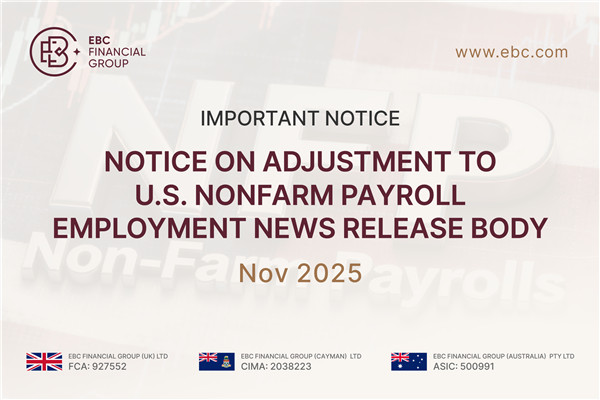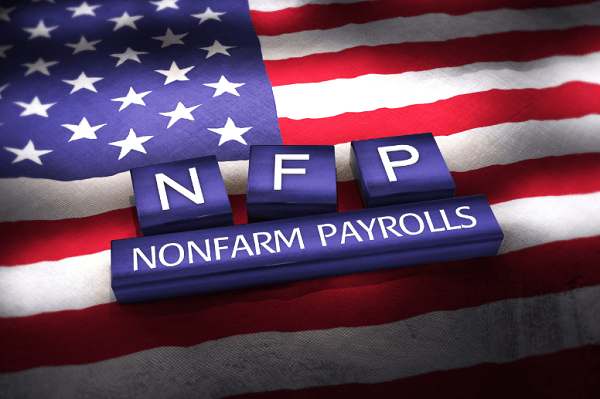Key Takeaways
The October 3, 2025, NFP report was postponed due to the U.S. federal government shutdown that began on October 1, 2025.
BLS has suspended all data collection and publication, including NFP releases for October and November 2025.
No new Nonfarm Payroll (NFP) data has been released since August 2025, which showed an increase of 22,000 jobs and an unemployment rate of 4.3%.
Traders should treat all future NFP release dates as tentative until the BLS resumes operations.
Market volatility may rise as investors increasingly rely on private-sector indicators such as the ADP report and ISM employment indices in the absence of official data.
The U.S. Bureau of Labour Statistics (BLS) publishes the monthly Employment Situation (the "NFP" or jobs report) at 8:30 AM ET on the first Friday of each month (unless a holiday changes the date).
In 2025, the BLS schedule put the Employment Situation releases on (reference-month → release date, all times ET). For example, the next NFP release: October (for Sep) → October 3, 2025, 08:30 AM.
However, due to the ongoing U.S. federal government shutdown that began on October 1, 2025, the BLS has temporarily suspended data collection and publication.
The October 3 Nonfarm Payroll (NFP) report release was officially postponed, and subsequent reports for November and December 2025 remain at risk of delay until government funding is restored. Traders should treat all dates below as tentative.
Official 2025 NFP Release Calendar (Tentative)
| Reference month |
BLS release date (2025) |
Release time (ET) |
| December 2024 (published Jan 2025) |
Jan 10, 2025 |
8:30 AM |
| January 2025 |
Feb 7, 2025 |
8:30 AM |
| February 2025 |
Mar 7, 2025 |
8:30 AM |
| March 2025 |
Apr 4, 2025 |
8:30 AM |
| April 2025 |
May 2, 2025 |
8:30 AM |
| May 2025 |
Jun 6, 2025 |
8:30 AM |
| June 2025 |
Jul 3, 2025 |
8:30 AM |
| July 2025 |
Aug 1, 2025 |
8:30 AM |
| August 2025 |
Sep 5, 2025 |
8:30 AM |
| September 2025 |
(Originally Oct 3 → Delayed due to shutdown) |
Pending update |
| October 2025 |
(Originally Nov 7 → Tentative Pending Shutdown Resolution) |
Pending update |
| November 2025 |
(Originally Dec 5 → Tentative) |
Pending update |
Note: The Employment Situation release covers the previous month's employment data (e.g., the September 5 release reports August payrolls). As of November 2025, no new NFP data has been released since the August report due to the funding lapse.
Always double-check the BLS calendar or broker news close to the date because official schedules can change for unscheduled reasons (holidays, agency decisions, or government shutdowns). [1]
Why Traders Always Ask When Is NFP?

Think of NFP like the economy's monthly heartbeat slowing down or speeding up, and traders react immediately. The NFP headline figure (change in nonfarm payroll employment), along with the unemployment rate and average hourly earnings, collectively shape expectations regarding consumer spending, inflation, and ultimately the Federal Reserve's policies.
In short, NFP moves currencies, Treasuries, equities, and volatility, often within minutes. Market makers refer to the immediate moments following the release as "the NFP window" for a reason.
The BLS publishes the Employment Situation on a fixed schedule (monthly at 8:30 AM ET). That consistency makes NFP a predictable, yet highly impactful, event in every trader's routine.
At least, that was the case until the October 2025 shutdown, marking the first time in decades that NFP data wasn't released on schedule, leaving markets temporarily "flying blind."
For traders focused on USD pairs, interest rates, or U.S. equities, staying informed about the NFP schedule is essential to know when data is released and to anticipate possible disruptions caused by the shutdown.
The Latest NFP Data So Far (2025)
The U.S. labour market in 2025 has been like a marathon runner losing steam after a strong start. It is still moving forward, but at a slower pace. Traders are watching closely because even small changes in job growth can swing expectations for the Fed and ripple across markets.
No official NFP reports have been released since the August 2025 data due to the shutdown. Below are the most recent available figures before the disruption:
| Month (reference) |
Initial headline jobs added |
Revision (latest) |
Notes |
| June 2025 |
+147,000 |
↓ revised down |
Stronger-than-feared initially, but later trimmed back. |
| July 2025 |
~73,000 |
↑ revised to ~79,000 |
Weak but slightly improved with revisions. |
| August 2025 |
+22,000 |
N/A (first release) |
One of the weakest prints in years, signalling hiring stall. |
Since then, unofficial private-sector estimates (e.g., ADP and ISM surveys) suggest job growth has remained subdued, and the unemployment rate may have crept closer to 4.4–4.5% by October.
Takeaway: Revisions matter. What looks "good" or "bad" on release day can shift weeks later when the BLS updates prior months. Traders who ignore revisions risk trading the wrong narrative.
| Indicator (Aug 2025) |
Latest Value |
Why It Matters |
| Unemployment rate |
4.3% |
Edging higher from earlier in 2025, showing slack in labor demand. |
| Average hourly earnings |
~4.0% y/y |
Sticky wage growth risks keeping inflation pressure alive even with slower hiring. |
| Labour force participation rate |
~62.6% |
Stable but below pre-pandemic highs; reflects how many are in the job hunt. |
Additionally, sometimes wages and participation speak louder than payroll. For example, even with weak August payrolls, steady wage growth could keep the Fed cautious on cutting too aggressively. Markets care about the mix: weak jobs with strong wages = tricky inflation puzzle.
How to Avoid Common Mistakes Traders Make During NFP Release

1. Assuming the Report Will Come Out as Scheduled
In 2025, that assumption failed. Always verify the BLS's operational status and broker updates before release week.
2. Chasing the Headline in the First Seconds
Liquidity is worst in the immediate spike; market orders can be toxic.
Solution: wait for the first structural move (10–30 minutes).
3. Ignoring Revisions
A massive downward revision in prior months can change the trend story.
Solution: Always read the PDF or release note for revisions and survey comments.
4. Looking Only at Payrolls
If payrolls are weak but wages accelerate, inflationary worries can strengthen the USD, making the reaction counterintuitive.
5. Over-Leverage Based on a Single Print
NFP is only one input. Don't let it dictate your whole portfolio unless you have a clear thesis and hedges.
What Traders Should Monitor After the NFP Print or Delay?

1. Fed Reaction & Communication Gaps
A series of missing NFP reports due to the shutdown complicates policy guidance. The Fed has warned it may need to rely more on private data and other indicators until BLS reports resume.
2. Yield Curve Moves
The 2s/10s Treasury curve spread is highly sensitive to growth and inflation outlooks, with unexpected NFP results or the absence of data prompting rapid market shifts.
3. Commodity Flows
Energy and base-metal prices may move as demand expectations shift; commodity exporters and EM FX respond.
4. Equity Sector Rotation
Banks, cyclicals, and industrials typically prefer hot jobs; consumer staples and REITs prefer stability. Tech remains rate-sensitive.
Frequently Asked Questions
1. When Is the Next NFP Release in 2025?
Initially scheduled for October 3, 2025, the next NFP release has been delayed indefinitely due to the government shutdown. As of November 2025, no new date has been announced.
2. Can NFP Be Leaked Early?
No credible leaks are allowed as BLS controls release access tightly. Any leak would be a major scandal.
3. Why Does the NFP Report Matter to Forex Traders?
Because it directly affects the U.S. dollar (USD), interest-rate expectations, and volatility in major currency pairs such as the EUR/USD, GBP/USD, and USD/JPY.
4. Does NFP Always Come Out on the First Friday of the Month?
Yes, but if there's a U.S. holiday or government shutdown, the release will shift to a later date.
5. What Was the Weakest NFP Report in 2025 So Far?
As of August 2025, the weakest report came in with just +22,000 jobs added, marking a sharp slowdown in U.S. hiring.
6. Can NFP Data Impact Gold Prices?
Yes. Gold often rallies if NFP is weak because traders expect lower interest rates and a weaker dollar. Currently, with no new official data, gold prices have seen safe-haven demand amid macro uncertainty.
Conclusion
In conclusion, the Nonfarm Payrolls (NFP) report remains one of the most powerful market-moving events in global trading in 2025.
However, the October 2025 government shutdown has disrupted this rhythm, pausing official data releases and leaving markets temporarily without one of their most reliable signals.
As data releases resume, each report will carry heightened significance, with investors closely assessing both the pace of job growth recovery and the evolution of long-term wage pressures.
By diligently tracking the official schedule, shutdown developments, private-sector employment data, and revisions, traders can transform potential surprises into strategic trading opportunities.
Disclaimer: This material is for general information purposes only and is not intended as (and should not be considered to be) financial, investment or other advice on which reliance should be placed. No opinion given in the material constitutes a recommendation by EBC or the author that any particular investment, security, transaction or investment strategy is suitable for any specific person.
Sources
[1] https://www.bls.gov/schedule/news_release/empsit.htm





























